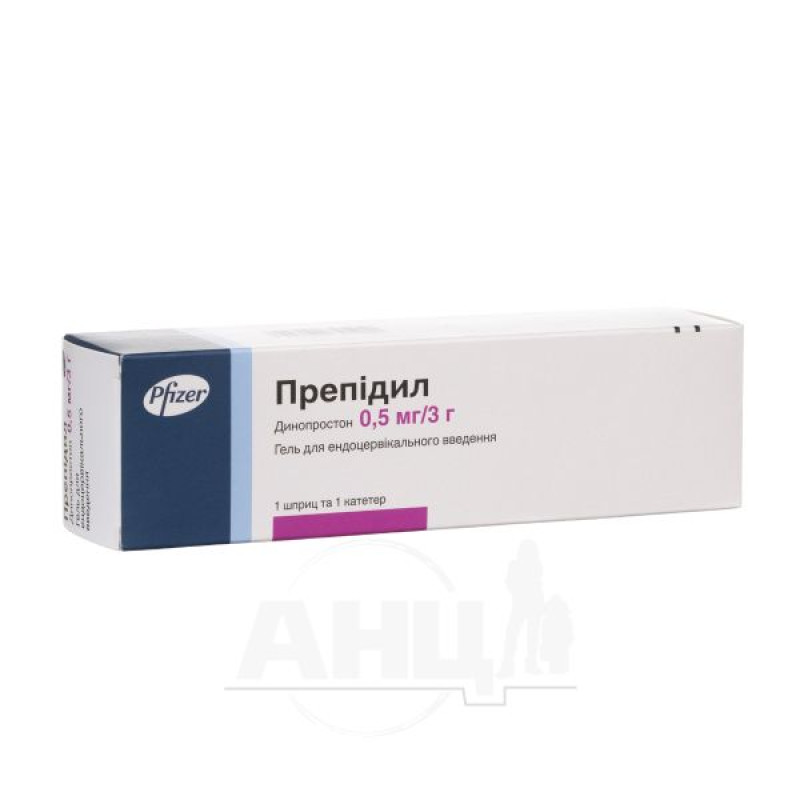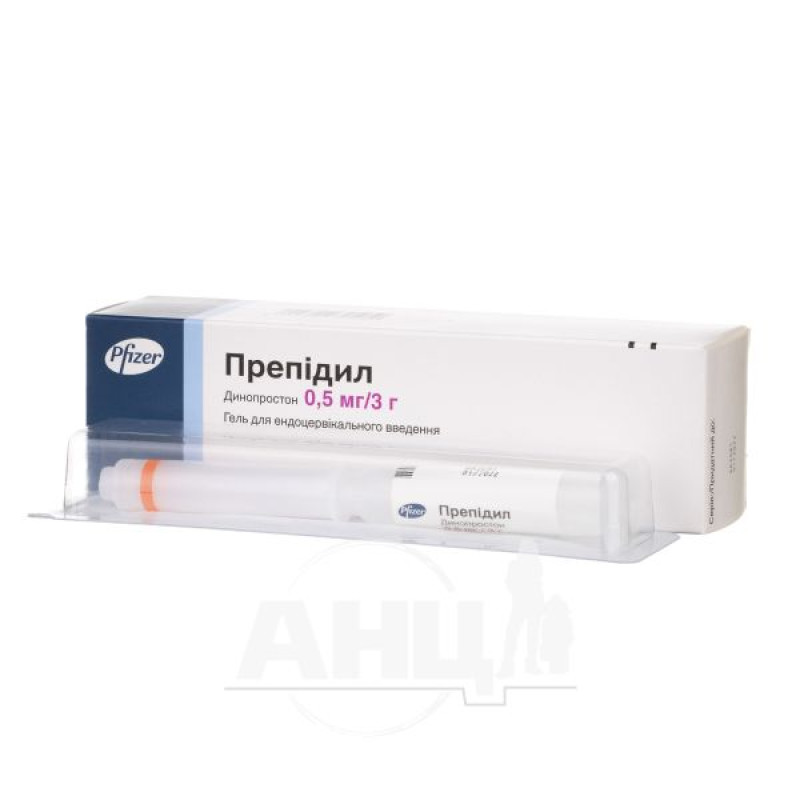Prepidyl gel for endocervical administration 0.5 mg/3 g syringe 3 g No. 1

Pharmacological properties
Pharmacodynamics. Dinoprostone or prostaglandin e2 (pge2) belongs to natural unsaturated fatty acids.
Prostaglandins have very diverse pharmacological properties, including the ability to stimulate organs that have smooth muscle and to modulate the response of organs to other hormonal stimuli.
Dinoprostone applied endocervically promotes cervical ripening in patients with negative induction indices. The mechanism of action of the drug is not fully understood. However, it has been experimentally established that in humans the drug increases the BCC in the tissues of the cervix in the same way as it occurs in the initial stages of spontaneous labor. These data clearly indicate that endocervical application of dinoprostone stimulates the hemodynamics of the cervix, thus promoting its ripening.
Pharmacokinetics. In the body, prostaglandins are rapidly formed from the corresponding free polyunsaturated fatty acids. These compounds have a pronounced effect even in minimal amounts, and then are rapidly transformed into inactive metabolites.
After endocervical administration at a dose of 0.5 mg (gel), the concentration of dinoprostone in blood plasma (in the peripheral circulatory system) reaches a maximum after 30-40 minutes, after which it quickly decreases to the initial level, regardless of the level of uterine activity.
The T½ of dinoprostone after injection is 1 min, while for each of the major metabolites it is ≈8 min.
Indication
The drug is prescribed for cervical ripening in pregnant women with full-term or near-term pregnancies, if labor induction is necessary for therapeutic or obstetric indications.
Application
For correct administration of the drug, the patient must be in a supine position, and the cervix must be visualized using a vaginal speculum.
Carefully insert the syringe into the cervical canal (just below the internal cervical os) and, using the attached catheter, carefully inject the entire contents of the syringe (0.5 mg dinoprostone = 3 g of Prepidil gel), then remove the catheter. Prepidil should not be injected above the level of the internal cervical os. After injecting the gel, the patient should lie on her back for at least 15 minutes to minimize gel leakage.
The contents of the syringe are for single patient use only. Do not attempt to administer the small amount of gel remaining in the catheter. The syringe, catheter and other parts of the drug packaging should be disposed of after use.
Instructions for using the syringe
Remove the sterile syringe and sterile catheter from the packaging.
1. Remove the protective cap (to use it as a piston).
2. Install the protective cap on the syringe.
3. Tightly attach the catheter to the syringe (a click should be heard) and inject the contents of the syringe into the patient.
Contraindication
- patients with hypersensitivity to Dinoprostone or any of the gel's excipients;
- patients for whom means that stimulate labor are contraindicated;
- in case of multiple pregnancy;
- women who have had ≥6 full-term pregnancies;
- if the fetal head is not presented in the birth canal;
- if there are scars on the uterus (after cesarean section, hysterotomy, etc.);
- if the size of the fetal head does not match the size of the mother's pelvis;
- if there is a change in the fetal heart rate, indicating fetal distress syndrome;
- if there are obstetric conditions in which the risk/benefit ratio for the mother or fetus indicates in favor of surgical intervention;
- if there is pathological uterine bleeding or discharge from the genital tract of unknown etiology during pregnancy;
- with non-occipital presentation of the fetus;
- for infectious diseases of the lower genital tract;
- history of difficult and/or traumatic childbirth;
- when the fetus is presented above the plane of the entrance to the small pelvis;
- with diseases of the heart, lungs, kidneys or liver in the active phase;
- when the amniotic sac ruptures.
Side effects
The frequency and severity of side effects caused by the use of dinoprostone depend on the dose of the drug and are to some extent determined by the method of administration. The following side effects have been noted during the use of the drug Prepidil.
At the mother's
Immune system disorders: hypersensitivity reactions such as: anaphylactic reactions, anaphylactic shock, anaphylactoid reactions.
On the part of the respiratory system, chest organs and mediastinum: wheezing, shortness of breath, feeling of lack of air, cough.
Gastrointestinal: diarrhea, nausea, vomiting.
Musculoskeletal and connective tissue disorders: back pain.
Impact on the course of pregnancy, postpartum period and perinatal conditions: impaired uterine contractile activity (increased frequency, tone or duration), uterine rupture, placental abruption, pulmonary embolism with amniotic fluid, rapid cervical dilatation.
Reproductive system and breast disorders: feeling of warmth in the vagina.
General disorders and administration site conditions: fever, pain.
Cardiac: cardiac arrest.
From the vascular system: arterial hypertension.
From the respiratory system: asthma, bronchospasm.
In the fetus/newborn
Impact on perinatal conditions: stillbirth, premature birth, deterioration of the health of newborns (7 points on the Apgar scale), fetal acidosis.
Sometimes body temperature may rise and leukocytosis may occur, but the indicators usually return to normal soon after treatment is stopped.
As with all intrauterine procedures, the risk of local infections during extraamniotic procedures should be considered. In such cases, infections should be treated.
During post-marketing surveillance, an increased risk of postpartum DIC has been described in patients undergoing pharmacological induction of labour, particularly with dinoprostone or oxytocin (see Precautions). However, the expected incidence of this adverse event is low (1 case per 1000 deliveries).
Special instructions
This drug is used only in a hospital setting.
Prepidil should be prescribed with caution to patients with a history of epilepsy, to persons with a history of cardiovascular, hepatic or renal dysfunction, as well as to patients with bronchial asthma (or a history of asthma), glaucoma (or with increased intraocular pressure). The use of the drug is contraindicated in case of rupture of the chorioamniotic membranes.
Before and during use of the drug, continuous electronic monitoring of uterine activity and fetal heart rate is recommended; it is also recommended to monitor cervical characteristics (dilation, softening and dilation) for timely detection of adverse reactions such as hypertonicity, uterine tetany or fetal distress syndrome.
Patients who develop uterine hypertonicity or increased contractile activity or who have an adverse fetal heart rate profile should be managed in a manner that ensures the overall safety of the mother and fetus.
As with any other means of stimulating labor, in the event of excessive uterine activity or uterine tenderness, the risk of uterine rupture must be considered.
Before using the drug Prepidil, it is necessary to carefully assess the proportional ratio of the size of the fetus and pelvis.
Animal therapy with high doses of the drug for several weeks has shown that prostaglandins belonging to the E and F groups can cause bone proliferation. A similar effect was observed in newborns receiving long-term PGE 1 therapy. With short-term therapy with Prepidil, a similar effect on bone tissue was not observed.
It is necessary to avoid the introduction of Prepidil gel above the level of the internal cervical os, since cases of uterine hyperstimulation have been observed with extraamniotic administration of the drug.
Women over the age of 35 who have had complications during pregnancy and women with a gestational age of 40 weeks are at increased risk of developing DIC in the postpartum period.
In addition, these same factors may contribute to an increased risk associated with induction of labor (see Adverse Reactions). Therefore, dinoprostone should be used with caution in such patients.
In the early postpartum period, appropriate measures should be taken as soon as possible to detect the possible onset of fibrinolysis.
The clinician should be aware that intracervical administration of dinoprostone gel may lead to unanticipated ruptures with subsequent embolization of antigenic tissue and the development of a rare anaphylactoid syndrome of pregnancy (amniotic fluid embolism).
Use during pregnancy and breastfeeding
Dinoprostone is indicated for use in women with full-term or near-term pregnancy or during labor.
PGE2 has been shown to increase the incidence of congenital skeletal anomalies in rats and rabbits. Dinoprostone has been shown to be embryotoxic in rats and rabbits, and any dose that causes prolonged uterine tone may pose a risk to the embryo or fetus (see Precautions).
Prostaglandins are excreted in breast milk in very low concentrations. No differences in drug concentrations were observed in breast milk of women who delivered prematurely and women who delivered at term.
Children: The drug is not intended for use in children.
The ability to influence the reaction rate when driving or working with other mechanisms. The drug is used only in a hospital setting.
Interactions
The effect of oxytocin may be enhanced by the administration of exogenous prostaglandins. Therefore, the simultaneous use of these two drugs is not recommended. With the sequential use of these drugs, careful monitoring of the patient's health is recommended. It is recommended to observe a time interval of at least 6 hours between the use of oxytocin and dinoprostone.
Overdose
Prepidil is intended for use only in single doses, therefore symptoms of overdose may occur only in individual patients with hypersensitivity to the drug. Since clinical studies of prostaglandin antagonists have not yet yielded results sufficient to make recommendations, treatment of overdose is still symptomatic.
Due to the transient nature of PGE 2 -induced myometrial hyperstimulation, it has been established that conservative treatment is effective in most cases of overdose, i.e., a change in body position and the use of oxygen for the mother are indicated.
If uterine hyperstimulation (and/or fetal distress syndrome) does not resolve after discontinuation of treatment, intravenous β-adrenergic agents may be appropriate. If tocolytic agents are ineffective, immediate delivery is recommended.
Storage conditions
In the refrigerator at a temperature of 2-8 °C.
There are no reviews for this product.
There are no reviews for this product, be the first to leave your review.
No questions about this product, be the first and ask your question.











